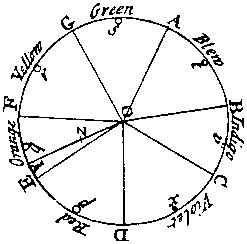
When the consciousness is awakened with the light of truth, if only for a fraction of a second, its radiance never entirely withdraws but filters quietly into our everyday life, for the most part unnoticed. -- G.F.K.
The theme of wheels within wheels is an electric metaphor that prods memory, imagination, and intuition into a virtual picture-making activity. The first image that popped up for me was an expansive cosmic setting of consciousness itself. Contemporary astrophysicists are now recognizing something they call the "Great Attractor" (1) -- a yet to be perceived wheeling superforce of superclusters of galaxies that flow and gravitate towards it. Within superclusters there are swarming curds of smaller clusters of galaxy structures which, in turn, are teeming with countless star-lives. Each starpoint, moving and staying like white water, is a hub to its own solar system, from spent ones like supernovas to oncoming protoplanetary disks and their evolving humanities -- humanities very capable of looking back up into their heavenly roots and also down into the infinitesimal eddies of the fluid forces of atomic, subatomic, and quantum worlds -- worlds within worlds ad infinitum!
From within this mind-filled world of consciousness and in our inherent stages of evolution, we have come to realize that we are, as in Anne Morrow Lindbergh's poem, The Unicorn, "horizontally in captivity yet perpendicularly free"; free to explore and invent our way through this labyrinth of light-forces we call the electromagneticphoton spectrum. This is a spread of radiant energy/matter that conceptually ranges in wavelengths from zero to infinity. Within the last 200 years scientists have divided it into seven basic regions: visible light, infrared, ultraviolet, radiowaves, x-rays, gamma rays, and microwaves -- waves within waves!
The specific wheel I want to discuss is the color wheel because color excites, shapes, and promotes life as we can know it. Everything manifested is borne and sustained by this electro-magical web of rays. The color wheel is our soul's mode of transportation through this underworld of radiating life-forms. It is a unicycle, a concentric glory that is at once a self-balancing dynamic of simultaneous contrasts and harmonies of structures, apparent and yet occult until we approach this wonder-wheel with curiosity and experimentation.
The inventive experimenter Isaac Newton flayed our crystalline thin air and exposed the hitherto occult prismatic-light spectrum, setting in motion an avalanche of scientific inquiry and literary metaphor. Further it was the resident genius in Newton who intuitively and profoundly proclaimed: "For the rays to speak properly are not coloured."
Well over 200 years later, an updated curiosity-seeker and Professor of Applied Optics, W. D. Wright, questions then answers:
If the rays are not coloured, what are they? . . . we might describe them as carriers of information -- information about the disposition of an object to reflect this or that sort of light more copiously than the rest.
When a coloured surface is illuminated, some of the incident energy is absorbed and some is reflected back after penetrating into the colorant layer [which we now realize is invisible]. It is the absorption or subtraction of the energy in specific parts of the spectrum which gives the surface its colour. (2)
Not only are the rays that carry and give color not colored, but every single color perceived in nature hides within itself the diametrically opposite color in the color wheel; hence, simultaneous contrast. Johannes Itten, famed Bauhaus teacher, tells us: "Simultaneous contrast results from the fact that for any given color the eye simultaneously requires the complementary color and generates it spontaneously. The simultaneously generated complementary occurs as a sensation in the eye of the beholder. It is not objectively present. It cannot be photographed." (3) The simultaneous contrast of green is red; yellow hides violet; orange gives off blue; indigo shows gold; and vice versa, as shown in the following figure from Newton's Opticks:
Illustration: 
Color within color (light within pigment or matter) is but one of many prizes held within this Wheel of Fortune -- our spectral glory.
Roger Shattuck, in his philosophical exposition of simultanism, says that it "evolved as both logic and artistic technique. It found a childlike directness of expression free of conventional order. It maintained an immediacy of relationship between conscious and subconscious thought [between material and spiritual thought]. It encompassed surprise, humor, [and] ambiguity." (4)
Quantum physicist and philosopher, Arthur Zajonc reminds us that Goethe "saw the human being as constantly engaged in a process of self-formation. We have learned that even natural organs, such as the eye, require imagination to see." Zajonc also says that "Goethe emphasized the importance of a light that is within. In his words, 'If the eye were not sun-like how could we perceive the light?'" (5)
Let's see this "self-forming" truth for ourselves by following this simple recipe (of "surprise, humor and ambiguity") by color theorist Wucius Wong: "We can see the after-image [simultaneous contrast] of a color by staring at a small color sample laid on white paper. If after thirty seconds or more, our eyes shift from the color sample to the white background, we see an illusion of the shape of the color sample in the complementary hue." (6)
Here sits a Blue Buddha for you: look at the center of the Buddha for thirty seconds, then shift your gaze to the right.

Wheels within wheels, worlds within worlds, waves within waves, color within color. This experiment demonstrates the equation that simultaneous contrast is like saying the light of spirit is within matter. (7)
FOOTNOTES:
1. Alan Dressler, Voyage to the Great Attractor, Exploring Intergalactic Space, Alfred Knopf, New York, 1994, p. x. (return to text)
2. W. D. Wright, The Rays are not Coloured, Essays on the Science of Vision and Colour, American Elsevier, New York, 1968, pp. 2-3. (return to text)
3. Johannes Itten, The Art of Color, The Subjective Experience and Objective Rationale of Color, Van Nostrand Reinhold Co., New York, 1973, p. 87. (return to text)
4. Charles A. Riley II, Color Codes: Modern Theories of Color in Philosophy, Painting and Architecture, Literature, Music, and Psychology, University Press of New England, Hanover and London, 1995, p. 118. (return to text)
5. Arthur Zajonc, Catching the Light, The Entwined History of Light and Mind, Bantam Books, New York, 1993, pp. 204-5. (return to text)
6. Wucius Wong, Principles of Color Design, Van Nostrand Reinhold, New York, 1987, p. 53. (return to text)
7. Cf. A. Trevor Barker, The Mahatma Letters to A. P. Sinnett, Theosophical University Press, Pasadena, 1994, p. 30. (return to text)